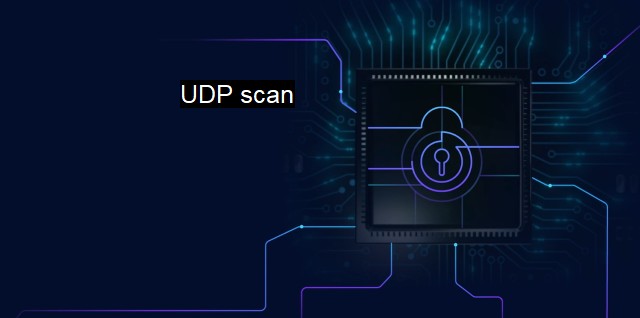What is UDP scan?
UDP Scan: Understanding How Attackers Identify Network Vulnerabilities and Exploit Them
Unreliable Datagram Protocol (UDP) scanning is a critical technique that hackers use to reveal potential points of entry in a system. It's a technique that sends out UDP datagrams to different ports on a target machine to learn about available services and to manipulate or exploit the network. In fact, recognizing this risk, many antivirus solutions today have evolved techniques for identifying and thwarting suspected UDP scans.Understanding the UDP Protocol needs a bit of understanding of Internet Protocol (IP). IP, as the primary communicative protocol used across the internet, works in tandem with either the Transmission Control Protocol (TCP) or the User Datagram Protocol (UDP). These two protocols correspond to the transport layer of the Internet Protocol Suite, more commonly known as TCP/IP, with the latter being the database revealing the networking framework behind the internet.
While TCP, known for its dependable delivery system ensuring zero data loss, is analogous to a phone call where information transmitted is broken down into sequenced packets, the UDP is much like a postcard service - smaller, faster, less reliable, but sufficient for situations where speed takes priority over reliability. Thus, its uses are typically confined to streaming services, broadcasting, gaming, and occasionally, domain name services (DNS) where immediate interaction outweighs perfect packet delivery.
It is this nature of UDP that forms the core of a UDP scan. Unlike TCP, UDP does not have a three-way handshake to establish a connection. In a normal scenario, when UDP packets are sent to an open port, the receiving system does not send back any acknowledgement. if a packet is directed to closed ports, the system typically sends an Internet Control Message Protocol (ICMP) error message. Utilizing this behavior, a UDP scan expedited by cyber criminals can examine machines by sending UDP packets and monitoring responses to single out open, potentially vulnerable, ports.
A powerful tool in any hacker's array, the UDP scan can swiftly bypass firewalls and slide under the radar of several intrusion detection systems (IDS). It can also effortlessly maintain the general user's anonymity in a system. As UDP never establishes a full connection, many systems have a bypass in place allowing UDP packets, effectively making invasions extremely difficult to identify and forestall.
Despite the UDP scan's potential as a cybersecurity threat, many modern antivirus systems have adopted measures of protection against potentially rogue scans. By habitually observing network traffic for patterns typical of UDP scans, these safeguards undertake action almost immediately. They take snapshots of network traffic, administer heuristic analysis to detect variations from the norms, and appropriately ramp up security protocols to face the said divergence. Consequently, databanks of threat intelligence are cross-referenced to identify any historical significance that these variations may indicate, a system quite alike dealing with traditional viruses, only more dynamic and temporally aware.
It can be inferred that detection and prevention of such scans require continuous vigilance and regular updates to threat profiles. Novel exploits are often being unearthed, some even potentially disabling the ICMP messages, liberating the terminal to respond to a 'ping,' thus stressing the urgent need to remain updated in this cyber arms race to effectively manage security.
a UDP scan is a crucial reconnaissance technique in a hacker's toolkit, which seeks to identify open ports within a network using the built-in tendencies of the UDP itself but can be detected with diligent monitoring and safeguard measures that are ever-evolving in antivirus systems.+

UDP scan FAQs
What is a UDP scan and how does it relate to cybersecurity?
A UDP scan is a type of port scan that sends UDP packets to target ports on a network to identify any potential vulnerabilities. UDP scans are commonly used in cybersecurity to detect open ports that may be exploited by cybercriminals.What are some commonly used tools for performing UDP scans?
There are several tools that can be used to perform UDP scans, including Nmap, SuperScan, and Masscan. These tools allow cybersecurity professionals to scan networks for open UDP ports and identify potential vulnerabilities that could be exploited by attackers.What is the difference between TCP and UDP scans?
TCP scans and UDP scans are both used to identify open ports on a target network, but they use different protocols. While TCP scans rely on the Transmission Control Protocol (TCP), which establishes a connection between the scanning device and the target device, UDP scans use the User Datagram Protocol (UDP), which does not establish a connection. As a result, UDP scans tend to be faster, but may not provide as complete a picture of the network topology.How do antivirus programs protect against UDP scans?
Antivirus programs use a variety of techniques to protect against UDP scans and other types of network-based attacks. For example, antivirus programs may use behavioral analysis to detect patterns of suspicious network traffic, or they may use heuristics to identify known attack patterns. Additionally, antivirus programs may block traffic to known malicious IP addresses or to ports that are commonly used by attackers.| | A | | | B | | | C | | | D | | | E | | | F | | | G | | | H | | | I | | | J | | | K | | | L | | | M | |
| | N | | | O | | | P | | | Q | | | R | | | S | | | T | | | U | | | V | | | W | | | X | | | Y | | | Z | |
| | 1 | | | 2 | | | 3 | | | 4 | | | 7 | | | 8 | | |||||||